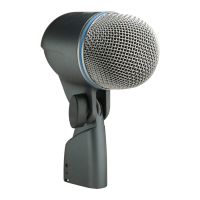Shure Incorporated
4/7
Application Suggested Microphone Placement Tone Quality
NOTE: To create a tighter sound with more
“punch,” place a pillow or blanket on bot
tom of the drum against the beater head.
Guitar & Bass Amplifiers
2.5 cm (1 in.) from speaker, on-axis
with center of speaker cone.
Sharp attack; emphasized bass.
2.5 cm (1 in.) from speaker, at edge
of speaker cone.
Sharp attack; higher frequency sound.
60 to 90 cm (2 to 3 ft.) back from
speaker, on-axis with speaker cone.
Softer attack; reduced bass.
Avoiding Pickup of Unwanted Sound Sources
Asupercardioidmicrophonehasthegreatestsoundrejectionatpoints120°towardtherearofthemicrophone.Placethemi-
crophone so that unwanted sound sources, such as monitors and loudspeakers, are at these angles, not directly behind it. To
minimizefeedbackandensureoptimumrejectionofunwantedsound,alwaystestmicrophoneplacementbeforeaperfor-
mance.
Recommended Loudspeaker Locations for Supercardioid Microphones
Proximity Effect
Unidirectional (cardioid) microphones progressively boost bass frequencies by 6 to 10 dB below 100 Hz when the microphone
is at a distance of about 6 mm (1/4 in.) from the sound source. This phenomenon, known as proximity effect, can be used to
create a warmer, more powerful sound. To prevent explosive low frequency sound during close-up use, the bass response
gradually rolls off. This provides greater control and helps the user take advantage of proximity effect.

